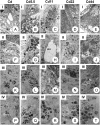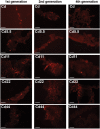Adaptation by death? Cell death-based tolerance to cadmium in 150-generation exposure of Spodoptera exiqua Hübner (Lepidoptera: Noctuidae)
- PMID: 37804089
- PMCID: PMC10724025
- DOI: 10.1093/ee/nvad077
Adaptation by death? Cell death-based tolerance to cadmium in 150-generation exposure of Spodoptera exiqua Hübner (Lepidoptera: Noctuidae)
Abstract
Mechanisms, including autophagy and apoptosis, which serve to regulate and ensure proper organism functions under optimal conditions, play additional defensive roles under environmental pressure. The aim of this study was to test the following hypotheses: (i) elevated autophagy and apoptosis intensity levels, as defensive processes in response to contact with cadmium, are maintained for a limited number of generations and (ii) the number of generations after which levels of cell death processes reach the reference level depends on selective pressure. Cell death processes were assessed by light and transmission electron microscopy, terminal deoxynucleotidyl transferase dUTP nick end labeling(TUNEL), and cytometric analyses. Model insects (Spodoptera exiqua, Hübner, 1808) were orally exposed to various concentrations of cadmium for 18 generations and compared with reference strains exposed to cadmium or not (control) for over 150 generations. Elevated programmed cell death intensity levels decreased after several generations, indicating tolerance of individuals to cadmium in the diet and verifying the first hypothesis; however, testing the second hypothesis indicated that the number of generations depended not only on pressure intensity, but also on cell death type, since levels of autophagy remained increased for a minimum of 12 generations.
Keywords: apoptosis; autophagy; tolerance.
© The Author(s) 2023. Published by Oxford University Press on behalf of Entomological Society of America.
Figures










References
-
- Augustyniak M, Płachetka-Bożek A, Kafel A, Babczyńska A, Tarnawska M, Janiak A, Loba A, Dziewięcka M, Karpeta-Kaczmarek J, Zawisza-Raszka A.. Phenotypic plasticity, epigenetic or genetic modifications in relation to the duration of Cd-exposure within a microevolution time range in the beet armyworm. PLoS One. 2016:11(12):e0167371. 10.1371/journal.pone.0167371. - DOI - PMC - PubMed
Publication types
MeSH terms
Substances
Grants and funding
LinkOut - more resources
Full Text Sources

